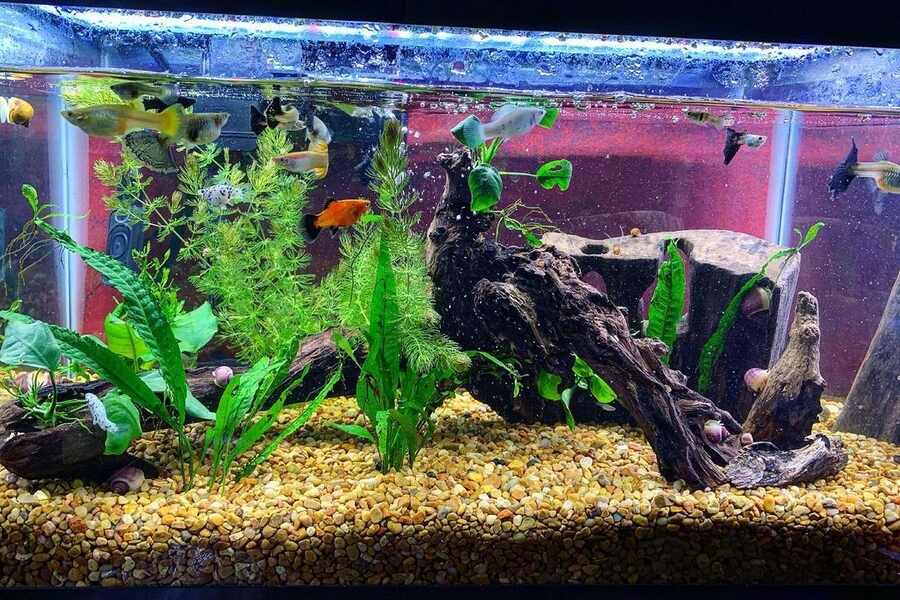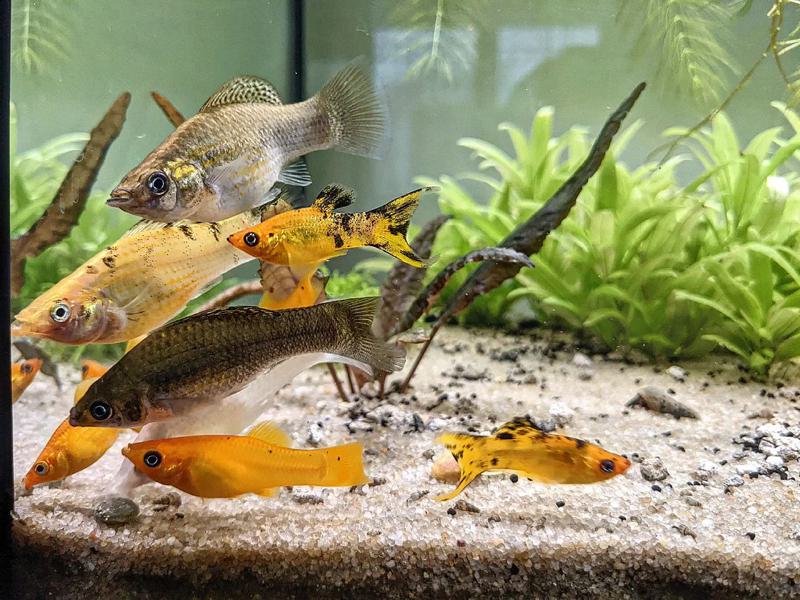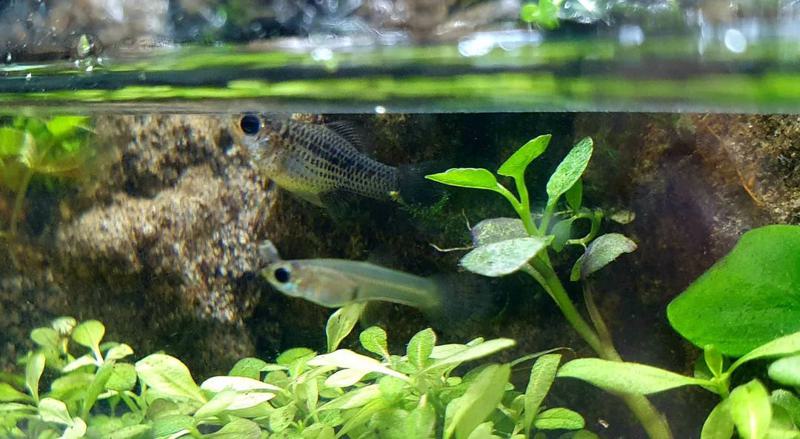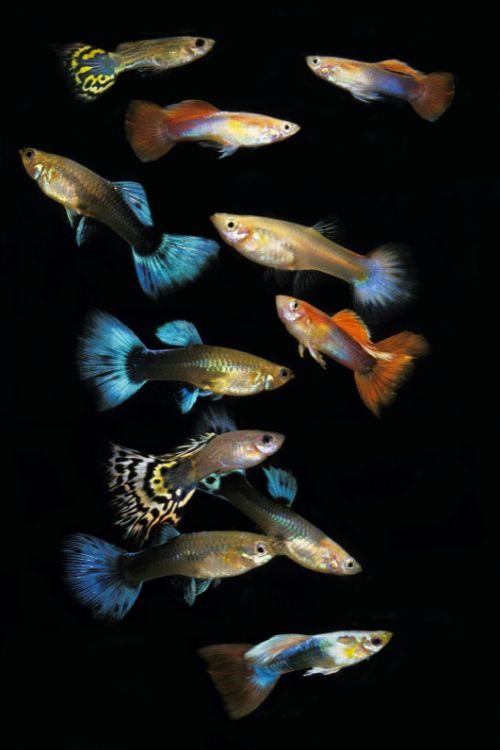Mollies and guppies are among the most common aquarium fish around the world, and they’re especially popular with novice aquarium owners due to their low maintenance requirements, their placid temperaments and their vivid, attractive colors.
However, one question many people ask is, can they be kept together in the same tank?

To help you understand the answer to this question and more, in this post, we have all the information you need about mollies and guppies.
What Are Guppies and Mollies?
Let’s start with the basics – what are mollies and guppies, how are they different and where do they come from?
Guppies and Mollies Genera
Mollies and guppies are two closely related species of fish of the genus Poecilia. The name of the genus comes from the Greek word poikilos, which means “having many colors”.
All fish in this genus except two are known as mollies – the other two are P. wingei, commonly called the Endler’s livebearer (also a popular aquarium fish), and P. reticulata, the fish best known as the guppy.
Where Do They Come From?
Both mollies and guppies are native to the Americas, although nowadays they can be found in the wild in many other parts of the world where they exist as introduced species.
Among the most commonly kept aquarium species is P. sphenops, the so-called short-finned or common molly, which has its natural range from Mexico down to Colombia. They live in freshwater streams and coastal brackish or marine waters.
Another common aquarium species, P. latipinna, the sailfin molly, is native to the US and Mexico, ranging from North Carolina through Texas and down in Mexico’s Yucatán Peninsula. This species prefers freshwater habitats but can also tolerate brackish water.
Guppies, on the other hand, originate from the northeast part of South America. They also prefer freshwater habitats, but like mollies, they can tolerate brackish water too.
What Do They Eat in The Wild?
Mollies and guppies in the wild have similar omnivorous diets. Most species enjoy a range of foods that includes algae, plant fragments, insect larvae, mineral particles, detritus and more.
Guppies and Mollies in Aquariums
Here are the essential details you need to know about domesticated guppies and mollies kept in aquariums.
Size
Mollies are the larger of the two types of fish and have an average size of around 4 inches. Guppies are generally smaller than mollies and grow to an average of around 2 inches.
Temperament
Mollies and guppies in aquariums are usually peaceful fish that easily tolerate other species and each other. However, there are some differences, so let’s look at these now.
Guppies
Guppies are more peaceful than mollies, but males may become aggressive towards each other when the ratio of males to females is too high or when there is not enough space.
The have also been known to nip top-swimming fish and those with prominent fins, although this is not so common.
Mollies

Of the two, mollies are more likely to display aggressive behavior. This can occur when the ratio of males to females is too high or when there is not enough space in the tank. In both cases, this may cause males to attack other males.
Although mollies are rarely aggressive towards other species, they may nip at the fins of guppies or other species with colorful or flowing fins.
What Are Their Ideal Conditions?
Since mollies and guppies have similar requirements, it should be quite easy to find a balance that suits both species.
Water
Both mollies and guppies do best in freshwater or water that is slightly saline – around one tablespoon of salt per five gallons of water is about right.
Temperatures
Mollies prefer temperatures of around 75-82°F while guppies are comfortable at around 72-82°F. This means that a temperature of around 77-80°F should be perfect for both species.
Population
Both species are happier and less aggressive when there is a higher proportion of females than males. If you aim to have around two to three females to each male, life for your guppies or mollies will be more harmonious. If the ratio of females is even higher, so much the better.
However, both mollies and guppies are shoaling fish so shouldn’t be kept alone.
Tank size
If you only want to keep guppies, since they are smaller than mollies, the minimum tank size you will need is 10 gallons. However, if you want to keep mollies – or mollies and guppies together – the tank should not be less than 20 gallons.
Of course, these are only minimum sizes, and both species will be even happier in larger tanks. For higher numbers of fish, you will also need bigger tanks.
Cleaning the water
Both mollies and guppies are active fish that enjoy swimming around, and as a result, they have big appetites. This means they create a lot of waste, so you should clean their water regularly if you want them to thrive.
As a general rule, you should change 30% of the water weekly – although this may vary, depending on the size of your tank and the number of fish you keep in it.
Due to their high waste production, adding a filter to the tank is also recommended.
What Can You Feed Them in Captivity?
Both mollies and guppies are omnivorous species, so for them to thrive, you should provide them with a varied diet – and since both mollies and guppies will eat the same things, you don’t need to worry about providing different food for each one.
If you have algae growing in your tank, mollies and guppies will help you with this problem by eating it. In addition, they will eat any live plants you grow in the aquarium, but you should also supplement this with blanched vegetables.
In the wild, they eat live food such as insect larvae, so giving them food like brine shrimp, daphnia and mosquito larvae will also help them stay in good health.
Finally, providing them with high-quality tropical fish flakes will ensure they are not lacking any nutritional elements from their diet.
As a treat, you can also give them bloodworms – but do so sparingly since they have a high fat content and can cause constipation in your fish.
Also, be careful not to overfeed your fish since both species will continue to eat after they are full. As a rule, give them as much food as they can finish in two minutes once or twice a day and no more.
Ornaments and Plants
Both mollies and guppies appreciate plenty of plants and other places to hide in their tanks since this is what they are used to in the wild. Plants such as java moss, duckweed, guppy grass and water sprite are all good choices.
Furthermore, you should also include pieces of driftwood or artificial ornaments for them to play around and hide in.
Guppies prefer to stay near the top or the middle of the tank, so the substrate is not important to them. However, mollies like a sandy substrate, so providing this will suit both species.
Breeding Mollies and Guppies
Here’s the information you need to know about breeding mollies and guppies in an aquarium.
Mating and Gestation
Both mollies and guppies will breed freely in captivity without any help. After mating, the gestation period lasts between 20 and 60 days.
Birth and Protecting the Fry
Both mollies and guppies are livebearers, which means the females give birth to live young rather than laying eggs.
The fry are independent at birth, but they are at risk of being eaten by either parent – this is especially common in smaller aquariums, but there is less risk if your fish are well fed.
If you want your fish to breed, there are several ways to help protect the fry. Possible options include removing the fry from the main tank, providing lots of places for them to hide from the adults or ensuring the adults are all well fed and don’t need to eat their young.
Fry can be fed on tropical fish flakes until they reach adulthood, but they can also be given food like baby brine shrimp or microworms.
Population Control
If you prefer to control the population of fish in your tank, there are also a couple of options.
One simple way is just to allow the parents to eat most of the fry. This might feel a little barbaric, but it is just one way that these fish naturally control their own populations.
Alternatively, by lowering the temperature of the tank slightly, you can discourage the fish from breeding.
Another possibility is just keeping male fish. However, this may cause them to become aggressive.
Alternatively, you could just keep female fish, but both species can store sperm for at least several months, and it is quite common for females to be pregnant when you buy them from the pet shop.
Once a male is introduced to the population, he may then fertilize the females, who may then continue to give birth to his offspring, even after he has died or been removed from the tank.
Sexing Mollies and Guppies
It’s usually easy to tell the difference between male and female mollies and guppies.
In both types, the males have a prominent gonopodium, a modified anal fin that is used for inseminating the females. Females also tend to be larger than males, while males usually display more vivid and ostentatious colors.
Hybrid Breeding

Since mollies and guppies are closely related, if you keep them together, it’s possible for them to mate and produce hybrid offspring.
These offspring usually have a body resembling that of a small molly but with the brighter coloring of a guppy.
However, when you keep mollies and guppies together, they usually prefer to mate with their own kind, and hybrid offspring are relatively rare.
Also Read:
- How to Make Guppies and Tetras Thrive Together?
- Can Guppies Live With Bettas?
- Can Goldfish Live with Guppies?
- Best Guppy Tank Mates
Two Beautiful Species of Fish that Can Live Peacefully Side by Side
As we have seen, guppies and mollies are closely related fish that can peacefully coexist without the need for much effort on your part.
As long as they have a large enough tank, the right water temperature, the right ratio of females to males and the right food, mollies and guppies will live in harmony, both with each other and with many other species of fish you might choose to keep.
